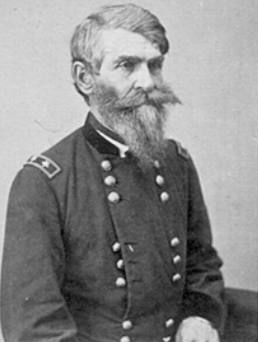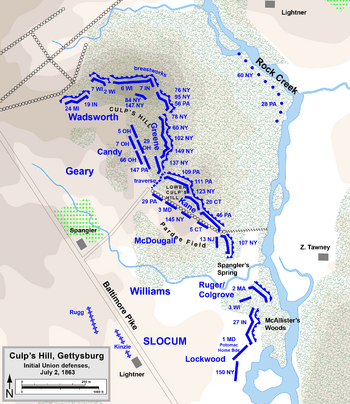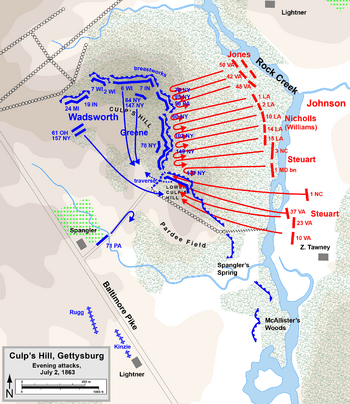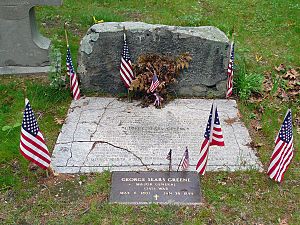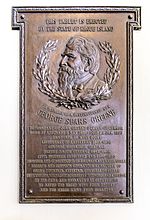George S. Greene facts for kids
Quick facts for kids
George Sears Greene
|
|
|---|---|
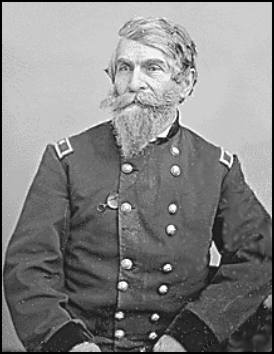 |
|
| Nickname(s) | Pap, Pappy, Old Man |
| Born | May 6, 1801 Apponaug, Rhode Island, US |
| Died | January 28, 1899 (aged 97) Morristown, New Jersey, US |
| Place of burial |
Greene Family Cemetery, Warwick, Rhode Island, US
|
| Allegiance |
|
| Service/ |
|
| Years of service |
|
| Rank |
|
| Commands held |
|
| Battles/wars | |
| Signature | |
George Sears Greene (May 6, 1801 – January 28, 1899) was an amazing American engineer and a brave Union general during the American Civil War. He came from a famous family in Rhode Island known for military service. He first joined the Army after graduating from West Point in 1823.
As a civilian, he helped start the American Society of Civil Engineers and Architects. He also worked on many important projects, like building railroads and water systems in the northeastern United States. After 25 years, he rejoined the Army to fight in the Civil War. Even though he was older, he quickly became a brigadier general in 1862. He fought in major battles like Battle of Antietam and Battle of Chancellorsville. His most famous moment was defending Culp's Hill at the Battle of Gettysburg. After the war, he went back to engineering until he passed away in 1899.
Contents
Early Life and Education
Greene was born in Apponaug, Rhode Island. He was one of nine children. His family had deep roots in Rhode Island and fought in the American Revolutionary War. His second cousin was General Nathanael Greene. George wanted to go to Brown University, but his family faced money problems. So, he moved to New York City and worked in a store.
In New York, Greene met Major Sylvanus Thayer, who was in charge of the United States Military Academy. Thayer suggested Greene for the academy. Greene entered West Point at age 18. He graduated second in his class of 1823. He chose to join the artillery. He stayed at West Point until 1827, teaching math and engineering. One of his students was Robert E. Lee.
In 1828, Greene married Mary Elizabeth Vinton. They had three children. Sadly, in 1833, his wife and all three children died, likely from tuberculosis. To cope with his sadness, he studied law and medicine. In 1836, he left the Army to become a civil engineer.
Engineering Career
Greene built railroads in six states. He also designed water and sewer systems for cities like Washington, D.C., and Detroit. In New York City, he designed the Croton Aqueduct reservoir in Central Park. He also worked on the High Bridge over the Harlem River. He was one of the twelve people who founded the American Society of Civil Engineers and Architects.
Later, he met Martha Barrett Dana and they married in 1837. They had six children together. Three of their sons later served in the military.
Joining the Civil War
Even though Greene was over 60 years old and had been out of the Army for 25 years, he felt he had to help save the Union. He was not very interested in politics, but he strongly believed in keeping the United States together. In January 1862, he became a colonel of the 60th New York Volunteer Infantry. The soldiers in this regiment were not happy with their previous leader. The governor of New York, Edwin D. Morgan, chose Greene because of his many years of Army experience. The soldiers were surprised to see an older, gray-haired man as their new colonel.
In April 1862, Greene was made a brigadier general. He served under Maj. Gen. Nathaniel Banks in the Shenandoah Valley against Stonewall Jackson. At 61, Greene was one of the oldest generals in the Union army. His troops called him "Old Man" or "Pap" Greene. Despite his age, he was a very aggressive and brave commander.
Battles and Leadership
Greene commanded the 3rd Brigade at the Battle of Cedar Mountain. His small force was attacked by a much larger Confederate army. But Greene and his men bravely held their ground. They fought until other Union units had to retreat. His division commander was wounded, so Greene temporarily took charge of the division.
At the Battle of Antietam, Greene again led his division. He launched a strong attack against the Confederates near the Dunker Church. His unit pushed farther into Stonewall Jackson's lines than any other Union force. Greene held his small division (only 1,727 men) in this advanced position for four hours. They suffered many losses but fought bravely.
At the Battle of Chancellorsville in May 1863, Greene's brigade was in the middle of the Union line. When the Union right side collapsed, Greene's brigade faced heavy artillery fire and infantry attacks. He had ordered his men to build strong defenses with abatis (fallen trees) and trenches. These defenses helped them hold off several Confederate attacks. They lost 528 men out of 2,032, but they held their ground. Greene again took temporary command of the division when his commander was wounded.
Hero at Gettysburg
The Battle of Gettysburg was the most important part of Greene's military career. On July 2, 1863, most of the Union forces were moved to strengthen the left side of their army. Greene's brigade of 1,350 New Yorkers was left alone to defend a half-mile line on Culp's Hill. An entire Confederate division attacked them. Luckily, Greene had insisted that his troops build strong defenses earlier. This was a smart move for an engineer!
In Greene's finest moment, his preparations saved the day. His brigade held off many attacks for hours. He was very active, encouraging his men to defend their positions in the dark. The fighting continued the next morning for over seven hours. But the Union troops held Culp's Hill. This battle involved the two oldest generals in each army: Greene at 62 and Confederate Brig. Gen. William "Extra Billy" Smith at 65.
The fierce fighting on the Union right flank was as important as the more famous defense of Little Round Top. Some argue it was even more important because the Union line was very close to a vital supply road. However, Greene's brave actions at this battle are not as widely known.
Fighting in the West
In the fall of 1863, Greene's corps was sent to the West to help Union forces at Chattanooga. At the Battle of Wauhatchie, during a surprise night attack, Greene was shot in the face. His jaw was crushed, and he lost some teeth. He suffered from this wound for the rest of his life. After six weeks of recovery, he returned to duty.
In 1865, he joined William T. Sherman's army in North Carolina. He fought at the battle of Kinston, where his horse was shot from under him. At the very end of the war, Greene helped capture Raleigh. He also chased Gen. Joseph E. Johnston's army until they surrendered.
After the War
After the war, Greene returned to his work as a civil engineer in New York and Washington, D.C. From 1867 to 1871, he was the chief engineer for the Croton Aqueduct Department in New York. When he was 86, he walked the entire 30-mile Croton Aqueduct to inspect it! He was also president of the American Society of Civil Engineers from 1875 to 1877.
By 1892, Greene was the oldest living Union general and the oldest graduate of West Point. He asked the United States Congress for a pension to help his family after he died. He was given a first lieutenant's pension, based on his highest rank in the regular army. On August 18, 1894, at 93 years old, Greene took the oath of office as a first lieutenant of artillery. He was the oldest lieutenant in the U.S. Army for 48 hours!
Legacy and Family
Greene passed away at age 97 in Morristown, New Jersey. He was buried in the Greene family cemetery in Warwick, Rhode Island. A two-ton boulder from Culp's Hill was placed on his grave. A statue honoring him was put up in 1906 on Culp's Hill at Gettysburg National Military Park.
Greene's wife, Martha, died in 1883. Their oldest son, Lieutenant Samuel Dana Greene, was an officer on the ironclad ship USS Monitor during the Battle of Hampton Roads. Another son, Francis V. Greene, led a brigade at the Battle of Manila during the Spanish–American War. A third son, Charles Thurston Greene, was wounded during the war but continued to serve.
A special plaque honoring Greene was approved by the Rhode Island government in 1910. This bronze plaque hangs inside the south entrance of the Rhode Island State House.
See also
- List of American Civil War generals (Union)
- Caleb Greene House
Images for kids
-
George S. Greene as a Brevet Major General


